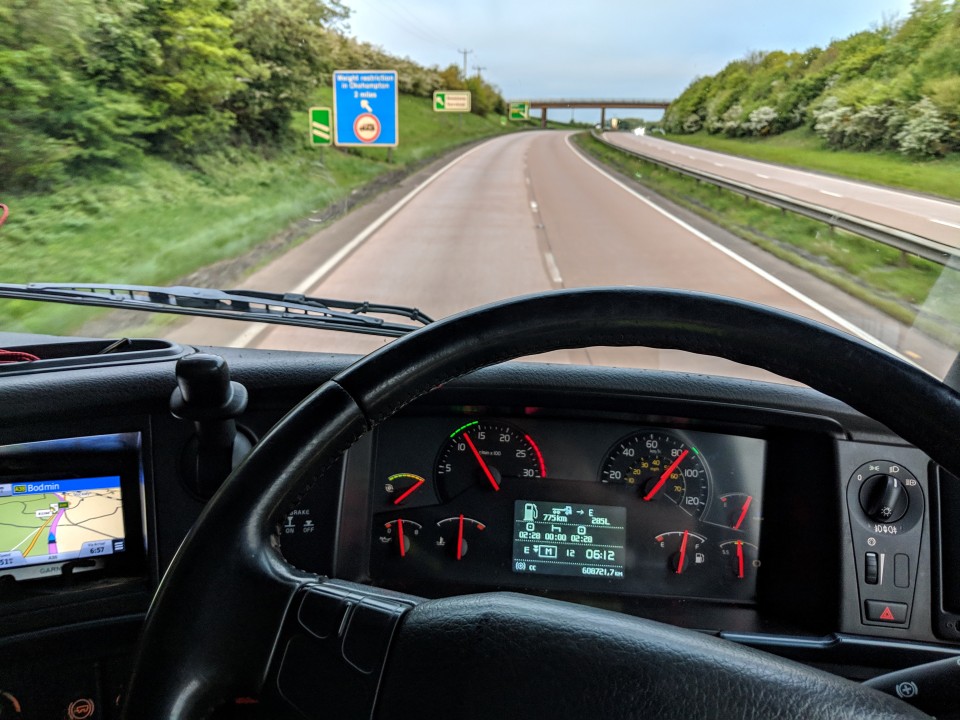
Susie Jones
Правила використання тахографа стали простішими
Створено: 01.08.2024
•
Оновлено: 08.08.2024
Світ правил використання тахографа може бути заплутаним навіть для найдосвідченішого водія вантажівки. Не кажучи вже про новачків у цій галузі. Ми прагнемо внести ясність у цю плутанину.
Що таке тахограф і навіщо він потрібен?
Згідно зі словником, тахограф - це "пристрій, який встановлюється в транспортних засобах, таких як вантажівки та автобуси, з метою запису такої інформації, як швидкість руху транспортного засобу, відстань, яку він проїхав, а також кількість перерв, які зробив водій".
Мета тахографа - запобігти втомі водія та забезпечити дотримання правил водіями та роботодавцями. [Благодійна організація з безпеки дорожнього руху Brake] (https://www.brake.org.uk/get-involved/take-action/mybrake/knowledge-centre/driver-fatigue) повідомила, що "чотири з десяти аварій, пов'язаних з втомою, відбуваються за участю водія комерційного транспортного засобу". Тому правила використання тахографів відіграють життєво важливу роль у зменшенні цього показника.
Коли потрібен тахограф?
Вам потрібно встановити тахограф, якщо ваша повна маса автомобіля перевищує три з половиною тонни. Важливо пам'ятати, що це стосується і буксирування причепа. З цього правила є кілька винятків:
Якщо ви їздите тільки по дорогах загального користування
Якщо транспортним засобом керують збройні сили, поліція або пожежна бригада
Якщо ви є комерційним автопарком і використовуєте транспортні засоби з максимальною вагою сім з половиною тонн, а ваш маршрут не перевищує 100 км від вашої операційної бази.
Якщо ви перевозите товари, а ваш транспортний засіб електричний
Якщо ви перевозите обладнання або техніку для використання водієм, і водіння цього транспортного засобу не є вашою основною роботою.
Які існують типи тахографів?
Існує три різних типи тахографів:
Аналогові: Стали обов'язковими в Європі в 1986 році. Аналогові тахографи використовують воскові паперові аркуші для запису даних водія. Водії вручну вводять дані і вставляють їх у пристрій тахографа.
Цифрові: Були запроваджені у 2006 році. Їх використовують понад мільйон транспортних компаній і понад шість мільйонів професійних водіїв. Цифрові тахографи записують дані водія на внутрішній накопичувач і картку водія.
Розумні: З червня 2019 року Європейський Союз зобов'язав компанії використовувати "розумні" тахографи. Вони автоматично реєструють місцезнаходження транспортного засобу на початку та в кінці кожної поїздки. Вони також надають оновлення кожні три години
Що означає кожен символ тахографа?
Перегляньте наше [відео] (https://www.youtube.com/watch?v=dgqGmlu9LfM&t=3s) з поясненням кожного символу тахографа
Порушення правил
Для безпеки водія вантажівки та всіх інших учасників дорожнього руху необхідно дотримуватися правил зупинки. Ми розбили ключові моменти.
Час у дорозі:
- Не може бути довшим, ніж чотири з половиною години до перерви
Перерви:
- Повинні становити щонайменше 45 хвилин, якщо водій не бере перерву на відпочинок
Період відпочинку:
- Під час періоду відпочинку не можна керувати автомобілем або виконувати будь-яку іншу роботу
Розбиття перерви на частини:
Повна 45-хвилинна перерва може бути розділена на 15-хвилинну перерву, за якою слідує 30-хвилинна перерва
Перерви для відпочинку повинні бути розподілені на чотири з половиною години водіння
Згідно з правилами ЄС, якщо перерви розділені, друга перерва має бути не менше 30 хвилин.

Щоденний ліміт водіння
Добовий ліміт водіння - це максимальний час водіння за день. Дев'ять годин - це максимум, але його можна збільшити до 10. Однак це можна робити не більше двох разів на тиждень. Щоденний час водіння може бути визначений наступним чином:
Загальний накопичений час водіння між закінченням щоденного періоду відпочинку та початком наступного щоденного періоду відпочинку
Загальний накопичений час водіння між щоденним періодом відпочинку та щотижневим періодом відпочинку. .
Тижневий та двотижневий ліміт водіння
Водії повинні стежити за тим, щоб не перевищувати максимальний тижневий та двотижневий ліміт водіння.
Максимальний тижневий ліміт водіння - 56 годин (застосовується до фіксованого тижня)
Фіксований тиждень починається о 00.00 і закінчується о 24.00 наступної неділі
Двотижневий ліміт водіння становить 90 годин.
Щоденний відпочинок
Крім того, необхідно щодня відпочивати.
Водій повинен відпочивати 11 годин безперервно. Це може бути скорочено до дев'яти
Таке скорочення може відбуватися лише до трьох разів між тижневими періодами відпочинку
Період відпочинку повинен бути завершений протягом 24 годин після закінчення останнього щоденного або щотижневого періоду відпочинку.
Щоденний відпочинок можна проводити в транспортному засобі, але для цього необхідно мати відповідні спальні місця. Якщо таких умов немає, водій повинен знайти собі житло. Перевірте нашу сторінку [місця] (https://www.snapacc.com/locations/), щоб дізнатися, які стоянки для вантажівок пропонують цю послугу.
Щотижневий відпочинок
Щотижневі періоди відпочинку повинні бути використані не пізніше, ніж по закінченні шести послідовних 24-годинних періодів з моменту закінчення останнього щотижневого відпочинку.
Водії зобов'язані відпочивати щонайменше 45 годин
Вони можуть мати скорочений щотижневий відпочинок тривалістю щонайменше 24 години
Скорочений щотижневий відпочинок потрібно компенсувати одним блоком, принаймні за дев'ять годин до кінця третього тижня.
Хоча скорочений відпочинок можливий, варто зазначити, що протягом двох тижнів поспіль, коли використовується скорочений відпочинок, його тривалість повинна становити 45 годин.

Багатомісний екіпаж
Деякі водії можуть брати на борт ще одного водія. Переваги включають підвищення продуктивності, більший пробіг та довший час у дорозі.
Обидва водії повинні мати дев'ять годин щоденного відпочинку
Цей щоденний відпочинок повинен відбуватися протягом 30 годин, а не 24.
Перша година мульти-меншингу не вимагає залучення іншого водія. Після однієї години це стає обов'язковим.
Поромні переправи або поїздки на поїзді
Як зазначено вище, регулярний щоденний період відпочинку водія повинен становити 11 безперервних годин, однак є кілька винятків з цього правила. За умови, що транспортний засіб супроводжується водієм, щоденний період відпочинку може перериватися двічі, але не повинен перевищувати однієї години в цілому. Наприклад, посадка та висадка на пороми та поїзди.
Якщо звичайний щоденний період відпочинку переривається таким чином, накопичений період відпочинку повинен становити щонайменше 11 годин або 12 годин, якщо він розділений на частини.
Що таке правило однієї хвилини для тахографа?
Правило однієї хвилини набуло чинності в жовтні 2011 року. Воно посилається на старе законодавство, яке детально описувало, що хвилина з щонайменше п'ятьма секундами водіння повинна була реєструватися як час водіння. Однак ЄС змінив це законодавство, і тепер найтриваліша безперервна діяльність, здійснена протягом хвилини, буде зараховуватися до цієї конкретної діяльності.
Що станеться, якщо я не буду дотримуватися правил використання тахографа?
Недотримання правил використання тахографа може призвести до штрафів, а іноді й до позбавлення волі. Як правило, покарання залежить від тяжкості порушення. За більшість порушень правил використання тахографа передбачені фіксовані штрафи. Водії мають до 28 днів на розгляд фіксованих штрафів.
У Великобританії існує два види штрафів та пені.
Штраф четвертого рівня: максимальний розмір штрафу становить 2 500 фунтів стерлінгів; цей ліміт діє для кожного штрафу за тахометр. Однак, у випадках з декількома порушеннями четвертого рівня може бути накладено максимальний штраф за кожне порушення.
Штраф п'ятого рівня: максимальний розмір штрафу становить 5 000 фунтів стерлінгів, однак, як і у випадку зі штрафами четвертого рівня, у разі кількох порушень може бути застосований максимальний штраф.
Правила використання тахографа можуть бути складними для розуміння. Однак їх недотримання може призвести до проблем з безпекою та потенційних штрафів. Розуміючи та дотримуючись правил, автопарки та водії можуть експлуатувати свої транспортні засоби безпечно та легально. Важливо зазначити, що правила і норми використання тахографів можуть відрізнятися в різних країнах.



